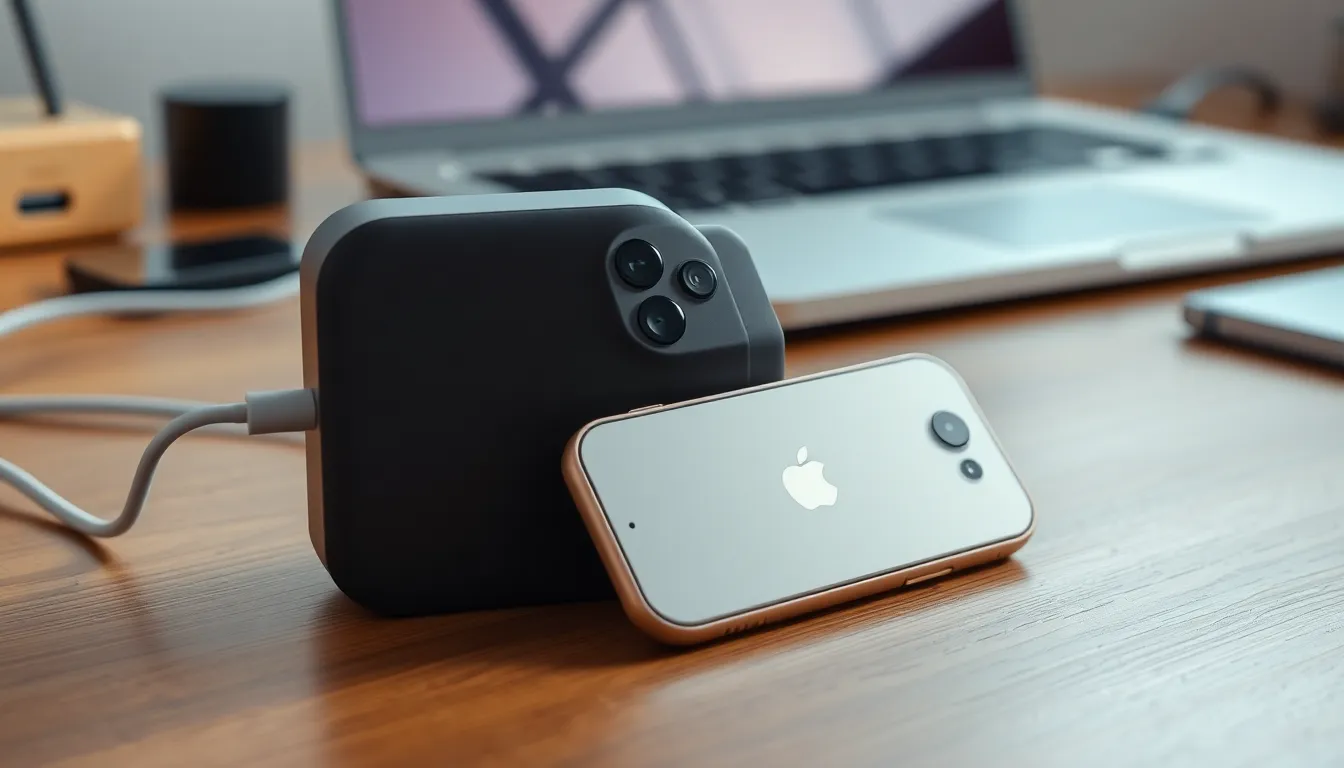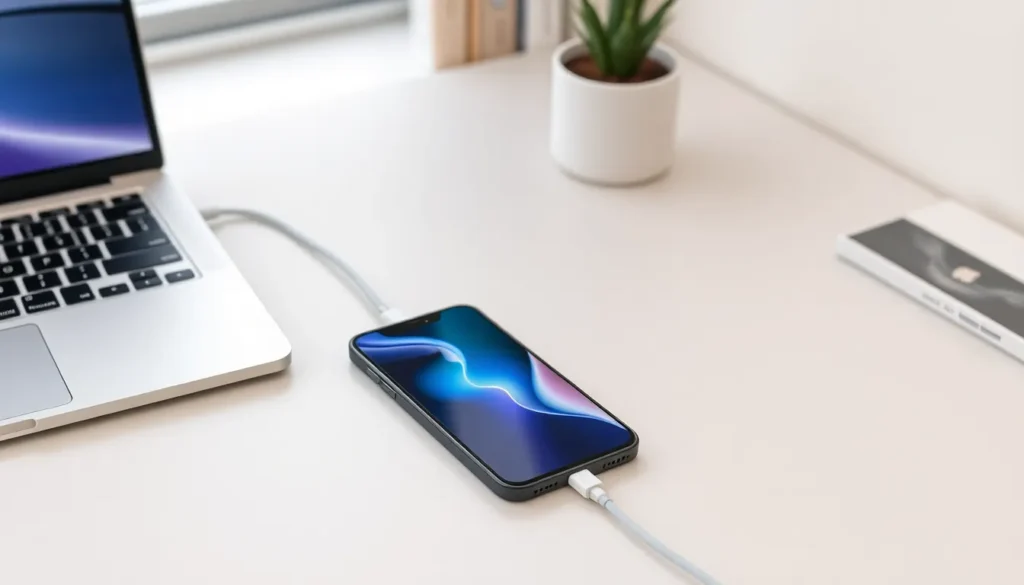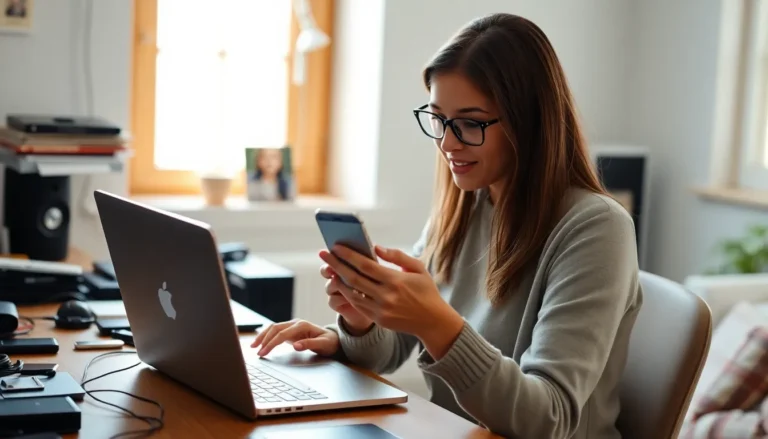Table of Contents
ToggleIn a world where charging cables seem to multiply like rabbits, the question arises: can you charge your shiny new iPhone 15 with your MacBook charger? Imagine the convenience of ditching that tangled mess of wires and using just one charger for both devices. It’s like finding out you can use the same remote for your TV and your streaming device—pure bliss!
But before you start plugging in like it’s a game of electrical roulette, let’s dive into the compatibility of these tech giants. Spoiler alert: it’s not just about the size of the connector; it’s about power delivery too. So, grab a seat and get ready to unravel the mysteries of charging your iPhone 15 with a MacBook charger—because who doesn’t love a good tech showdown?
Overview of Charging Compatibility
Charging compatibility between the iPhone 15 and a MacBook charger offers convenience for users. Both devices accommodate USB-C connections, but compatibility depends on various factors.
Understanding iPhone 15 Charging Requirements
The iPhone 15 supports various charging protocols, requiring a power input of up to 20 watts for optimal charging efficiency. This model utilizes USB Power Delivery technology, enabling faster charging when connected to compatible chargers. Users should note that standard USB chargers may provide lower wattage, which results in slower charging speeds. Additionally, the iPhone 15 can adapt to various power outputs, ensuring it charges safely even with different wattage levels.
MacBook Charger Specifications
MacBook chargers typically vary in wattage, ranging from 30 watts for MacBook Air to 96 watts for MacBook Pro. Each charger uses USB-C connectors and supports USB Power Delivery, matching the charging capabilities of the iPhone 15. These higher wattage ratings allow MacBook chargers to charge the iPhone 15 quickly without posing a risk of overheating or damaging the battery. Compatibility mostly hinges on the charger’s output, and devices handle wattage differences efficiently, ensuring effective power transfer.
Benefits of Using a MacBook Charger

Charging an iPhone 15 with a MacBook charger offers distinct advantages. Key benefits include faster charging potential and the convenience of using one charger for multiple devices.
Faster Charging Potential
Using a MacBook charger enables faster charging of the iPhone 15. With power outputs ranging from 30 to 96 watts, these chargers significantly exceed the iPhone’s 20-watt standard requirement. Quick charging is facilitated by USB Power Delivery technology, which optimizes energy transfer without risking overheating. Users can expect their iPhone 15 to charge much faster compared to using standard USB chargers. For example, a 30-watt MacBook charger can fully charge the iPhone 15 in a limited time, enhancing user efficiency.
Convenience of Using One Charger
Relying on a single charger simplifies daily routines. With a MacBook charger, users can charge both their laptop and iPhone 15 seamlessly. This eliminates the need to carry multiple chargers, reducing clutter. When traveling, a single charger becomes even more valuable, as it streamlines packing and ensures that devices remain powered. Switching between devices becomes effortless, allowing users to focus on their tasks without worrying about multiple charging solutions.
Potential Risks and Considerations
Charging an iPhone 15 with a MacBook charger poses certain risks that users should be aware of. Understanding these considerations helps ensure safe usage and device longevity.
Overheating Concerns
Overheating can occur when using a high-wattage charger with devices requiring lower wattage. MacBook chargers offer power outputs between 30 to 96 watts, significantly exceeding the iPhone 15’s 20-watt demand. In most cases, USB Power Delivery technology manages energy distribution efficiently, preventing excessive heat generation. However, prolonged charging while the iPhone is in use may increase the risk of overheating. Users should monitor the device during charging sessions, particularly when running intensive applications. If unusual warmth is felt, disconnecting the charger promptly is advisable.
Warranty and Support Issues
Using a MacBook charger for the iPhone 15 could lead to potential warranty concerns. Apple doesn’t explicitly endorse the use of MacBook chargers for iPhone models, which may impact warranty claims in instances of damage. Although third-party chargers and accessories generally qualify for support, choosing non-certified options could void certain warranties. Owners should carefully consider their charging methods to maintain both device integrity and warranty coverage. Documenting any damages and charging experiences helps clarify the approach should any issues arise.
User Experiences and Feedback
User experiences with charging the iPhone 15 using a MacBook charger reflect a mix of satisfaction and caution. Many appreciate the convenience of having one charger for multiple devices.
Positive Reviews
Users highlight faster charging times as a significant advantage. Reports indicate that the iPhone 15 charges from 0% to 100% in approximately 1.5 hours with a MacBook charger. A noticeable drop in cable clutter occurs as users no longer need to carry separate chargers. Moreover, they commend the charger’s ability to maintain safe heats, thanks to USB Power Delivery. Users feel confident that their device remains safe during the charging process.
Negative Feedback
Despite overall satisfaction, some users express concerns regarding overheating during extended use. They mention feelings of warmth when charging and using the iPhone simultaneously, prompting caution. Instances of reduced warranty coverage create hesitation, as Apple does not officially endorse this practice. Additionally, reports of slower charging speeds with certain third-party USB-C cables contribute to some negative experiences. Concerns like these remind users to stay mindful of their charging habits even when utilizing a MacBook charger.
Charging an iPhone 15 with a MacBook charger is not just possible but also offers several advantages. Users can enjoy faster charging times and the convenience of a single charger for multiple devices. However it’s essential to be aware of potential risks like overheating and warranty implications.
Monitoring the charging process and using quality cables can help mitigate these concerns. Many users have found success with this method, appreciating the efficiency it brings to their daily routines. Overall, while the benefits are significant, staying informed and cautious ensures a safe and effective charging experience.







